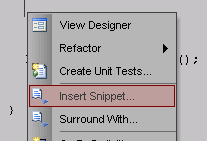.
1) The main constraint on overriding is that it needs permission from the base class with the 'overridable' keyword. Shadowing does not require permission of base class.
2) Overriding redefines only the implementation while shadowing redefines the
whole element.
Shadowing nothing but Hiding
in C# by using New keyword we can achive Shadowing
Solution for the QlikView, Biztalk, DotNet and MSBI real time development problems
Search This Blog
Monday, June 1, 2009
Visual Studio Code Snippets
There are a number of ways to do this in Visual Studio, the most common of which is to use regular intellisense. For instance, below we are about to add a for loop snippet:

You can also get to a menu of just snippets by using the right click menu and choosing the option "Insert Snippet". And, of course, if the mouse is too much work for you, there is a keyboard shortcut that will bring up this menu directly - ctrl-k + ctrl-x. Below, you can see the menu in action as we choose again to insert the for loop snippet.

You might be wondering "why would I want to use a for loop snippet?" - cause after all, a for loop it really isn't that complex to write. Well, what it does is give you the full for loop framework with only a couple keystrokes. This is what inserting the for loop snippet will give you:


You can also get to a menu of just snippets by using the right click menu and choosing the option "Insert Snippet". And, of course, if the mouse is too much work for you, there is a keyboard shortcut that will bring up this menu directly - ctrl-k + ctrl-x. Below, you can see the menu in action as we choose again to insert the for loop snippet.

You might be wondering "why would I want to use a for loop snippet?" - cause after all, a for loop it really isn't that complex to write. Well, what it does is give you the full for loop framework with only a couple keystrokes. This is what inserting the for loop snippet will give you:

OOPS
.
Abstraction
Abstraction is "the process of identifying common patterns that have systematic variations; an abstraction represents the common pattern and provides a means for specifying which variation to use" (Richard Gabriel).
An abstract class is a parent class that allows inheritance but can never be instantiated. Abstract classes contain one or more abstract methods that do not have implementation. Abstract classes allow specialization of inherited classes.
Polymorphism
Polymorphism allows objects to be represented in multiple forms. Even though classes are derived or inherited from the same parent class, each derived class will have its own behavior. Polymorphism is a concept linked to inheritance and assures that derived classes have the same functions even though each derived class performs different operations.
Virtual keyword
The virtual keyword allows polymorphism too. A virtual property or method has an implementation in the base class, and can be overriden in the derived classes.
To create a virtual member in C#, use the virtual keyword:
public virtual void Draw()
To create a virtual member in VB.NET, use the Overridable keyword:
Public Overridable Function Draw()
Override keyword
Overriding is the action of modifying or replacing the implementation of the parent class with a new one. Parent classes with virtual or abstract members allow derived classes to override them.
Abstraction
Abstraction is "the process of identifying common patterns that have systematic variations; an abstraction represents the common pattern and provides a means for specifying which variation to use" (Richard Gabriel).
An abstract class is a parent class that allows inheritance but can never be instantiated. Abstract classes contain one or more abstract methods that do not have implementation. Abstract classes allow specialization of inherited classes.
Polymorphism
Polymorphism allows objects to be represented in multiple forms. Even though classes are derived or inherited from the same parent class, each derived class will have its own behavior. Polymorphism is a concept linked to inheritance and assures that derived classes have the same functions even though each derived class performs different operations.
Virtual keyword
The virtual keyword allows polymorphism too. A virtual property or method has an implementation in the base class, and can be overriden in the derived classes.
To create a virtual member in C#, use the virtual keyword:
public virtual void Draw()
To create a virtual member in VB.NET, use the Overridable keyword:
Public Overridable Function Draw()
Override keyword
Overriding is the action of modifying or replacing the implementation of the parent class with a new one. Parent classes with virtual or abstract members allow derived classes to override them.
Subscribe to:
Comments (Atom)
Popular Posts
-
.Net Integration with Bill Desk Payment Gateway Introduction: Now-a-days online shopping websites has become very popular, and to h...
-
Applies To ASP.NET version 1.1 ASP.NET version 2.0 Summary This How To shows how you can help protect your ASP.NET applications from cr...
-
Confirmation box from code behind c# using modalpopup ajax control <% @ Page Language ="C#" AutoEventWireup ="true...
-
function numbersonly(e) { var unicode = e.charCode ? e.charCode : e.keyCode if (unicode != 8) { //if the key isn't the backspace key (...
-
Use below javascript function to 1) validate the date difference in asp.net 2) difference (number of days, months, years) between two dat...